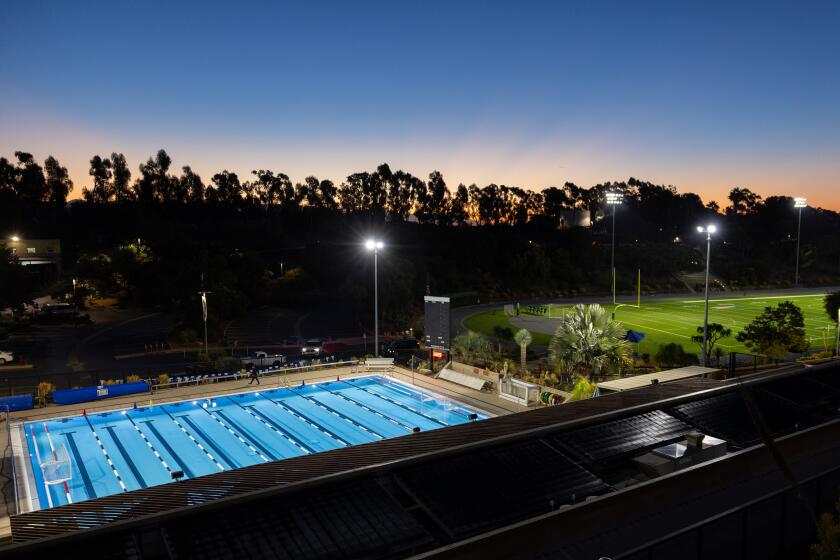Where a porn palace stood
- Share via
THERE’S AN INVIGORATING wave of revitalization sweeping through many communities in Los Angeles County. Housing that is affordable to the middle class is springing up in Pasadena and Long Beach, Venice and downtown, Silver Lake and MacArthur Park, Echo Park and Eagle Rock. Windows that were once boarded up are reopening. Abandoned buildings are filling up with residents. Art galleries are attracting young and old. Restaurants and nightclubs are bustling, and streets once avoided at night because of crime are crammed with customers.
What could be bad about that? New retail business is generating sales taxes. New homes are producing property taxes. These revenues, in turn, pay for new public safety efforts, new parks, new community cleanup work and improved roads.
Call it gentrification or call it revitalization. The result is undeniably positive for a community.
Gentrification can result in the displacement of poor and low-income renters who lack the money to live in any but the lowest-priced apartments in the most crime-ridden neighborhoods. That’s certainly something that policymakers have to try to address as neighborhoods change. But for local owners of homes and businesses, and for the community as a whole, gentrification’s net effect is overwhelmingly positive.
That’s why it is the goal of every down-on-its-luck neighborhood. City government led the makeovers of Old Town Pasadena and downtown Long Beach. Pasadena chartered the district with strict development guidelines and rules requiring the preservation of historic buildings. It allocated tens of millions of dollars for the project. Long Beach raised hundreds of millions in public and private money, bought out rundown properties, rezoned the area and sold land to developers. Both communities brought light-rail lines to the heart of their downtowns.
The arrival of the creative class is often the key to the transformation of down-and-out neighborhoods. Young software and Web designers, students and artists and entrepreneurs help reopen boarded-up buildings, clean up abandoned yards and repair the broken windows that represented a rapidly declining quality of life in an area. These new residents are generally attracted by low-rent lofts and similar converted rental housing, and they bring discretionary income and relatively low safety concerns (compared with families with children) to a neighborhood. Hip retailers open for business. New restaurants and nightclubs follow.
The change can be dramatic. At the depths of downtown Long Beach’s decline, one six-block area contained 19 bars, nine adult book stores and three adult theaters. The few residents lived in flophouses, deteriorating hotels or small apartments. Businesses and visitors were scarce because of safety concerns.
Recovery took 30 years and more than $1 billion in public and private money. Today, downtown Long Beach has 3 million square feet of new office space, a 30-acre park, a regional shopping mall, four first-class hotels, a successful convention center, multiple movie theaters, an internationally known aquarium and tens of thousands of new condos, homes and apartments. More than 15,000 jobs have been created.
Previous residents of the neighborhood were forced to relocate in some cases, but the revitalized downtown has generated tens of millions of dollars to pay for the construction of affordable housing and countless millions more for public safety, public parks and other city services. Its biggest problem is congestion -- cars and people.
Because of its spending, which creates tax revenue to pay for improved public safety, the creative class prepares the way for middle-class families seeking to buy their first homes. Pasadena, Long Beach, downtown L.A., Venice and Silver Lake have all reached a “tipping point” of gentrification -- an area’s increased safety attracts families, not just young singles. The resulting demand for houses attracts builders and developers. They invest private capital to renovate existing housing or to build new stock, and this new housing stock attracts upper-middle- and upper-class families looking to live closer to their workplaces or to buy larger dwellings than their suburban starter homes.
At this point, the neighborhood must decide whether to protect its local housing stock if it has historic significance (as Pasadena has done) or to allow large-scale housing renovation or replacement. As important as this decision is, it affects only the scope and character of gentrification, not its overall direction or success. For example, Pasadena banned high-rise development in Old Town, which altered the form and density of new housing. But construction proceeds.
The arrival of middle-class families in a gentrified neighborhood usually signals the beginning of the departure of the creative-class pioneers. As young artists and professionals marry, contemplate producing children or just get older, their lofts begin to look small and the appeal of urban living fades. New creative-class residents take over their lofts or the buildings are converted into more family-oriented condos. Such is the inevitable cycle of neighborhood recovery, and it represents the best opportunity to bring the middle class back to an urban setting, whether it be Pasadena, Long Beach or Silver Lake.
Gentrification is not a choice between having a Starbucks on the corner or preserving a historic theater, because the sales tax generated by all those lattes helps pay for the theater’s renewal. Revitalization means new life, new spirit, new safety and new appeal for the entire city and its residents.
More to Read
Sign up for Essential California
The most important California stories and recommendations in your inbox every morning.
You may occasionally receive promotional content from the Los Angeles Times.






